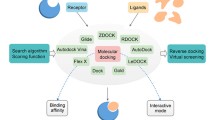Abstract
A single protein-binding pocket often times binds to a diverse range of ligands with distinct structural features. Understanding the structural correlations of the different ligands remains a major challenge in medicinal chemistry research. We recently developed the template-based alignment modeling (TAM) method as a simple yet effective approach for understanding structure–activity relationships (SARs) for a variety of medicinal agents. In this article, we briefly review the developmental process of TAM, and then showcase some potential applications. Finally, within the conceptual framework of TAM, we discuss our view of the structural correlation issue of diverse ligands.











Similar content being viewed by others
References
Anna Maria P (2018) From morphine to endogenous opioid peptides, e.g., endorphins: the endless quest for the perfect painkiller. Substantia 2(2):81–91
Aubry A, Birlirakk N, Sakarellos-Daitsiotis M, Sakarellos C, Marraud M (1988) Relationship of the crystal and molecular structure of leucine-enkephalin trihydrate to that of morphine. J Chem Soc Chem Commun 1988:963–964
Chang C, Ekins S, Bahadduri P, Swaan PW (2006) Pharmacophore-based discovery of ligands for drug transporters. Adv Drug Deliv Rev 58:1431–1450
Compton DR, Gold LH, Ward SJ, Balster RL, Martin BR (1992) Aminoalkylindole analogs: cannabimimetic activity of a class of compounds structurally distinct from delta 9-tetrahydrocannabinol. J Phafmacol Exp Ther 263:1118–1126
Eguchi M, Shen RY, Shea JP, Lee MS, Kahn M (2002) Design, synthesis, and evaluation of opioid analogues with non-peptidic beta-turn scaffold: enkephalin and endomorphin mimetics. J Med Chem 45:1395–1398
Harland AA, Bender AM, Griggs NW, Gao C, Anand JP, Pogozheva ID, Traynor JR, Jutkiewicz EM, Mosberg HI (2016) Effects of N-substitutions on the tetrahydroquinoline (THQ) core of mixed-efficacy mu-opioid receptor (MOR)/delta-opioid receptor (DOR) ligands. J Med Chem 59:4985–4998
Hua T, Vemuri K, Nikas SP, Laprairie RB, Wu Y, Qu L, Pu M, Korde A, Jiang S, Ho JH, Han GW, Ding K, Li X, Liu H, Hanson MA, Zhao S, Bohn LM, Makriyannis A, Stevens RC, Liu ZJ (2017) Crystal structures of agonist-bound human cannabinoid receptor CB1. Nature 2017:468–471
Montanari F, Ecker GF (2015) Prediction of drug-ABC-transporter interaction—recent advances and future challenges. Adv Drug Deliv Rev 86:17–26
Naaz F, Haider MR, Shafi S, Yar MS (2019) Anti-tubulin agents of natural origin: targeting taxol, vinca, and colchicine binding domains. Eur J Med Chem 171:310–331
Pascual R, Almansa C, Plata-Salaman C, Vela JM (2019) A new pharmacophore model for the design of sigma-1 ligands validated on a large experimental dataset. Front Pharm 10:519
Pradeep H, Rajanikant GK (2012) A rational approach to selective pharmacophore designing: an innovative strategy for specific recognition of Gsk3β. Mol Divers 16:553–562
Saito T, Hirai H, Kim YJ, Kojima Y, Matsunaga Y, Nishida H, Sakakibara T, Suga O, Sujaku T, Kojima N (2002) CJ-15,208, a novel kappa opioid receptor antagonist from a fungus, Ctenomyces serratus ATCC15502. J Antibiot 55:847–854
Wu Z (2013) Construction validation and application of an artificial template for the template-based alignment modeling on the N-terminal inhibitors of Hsp90. 246th ACS national meeting, September 8–12, 2013, Indianapolis, IN
Wu Z (2020) Template-based alignment modeling of the structure-activity relationships of CB2R ligands. ACS Spring 2020 National Meeting & Exposition. https://www.morressier.com/article/templatebased-alignment-modeling-structureactivity-relationships-cb2r-ligands/5e7374cfcde2b641284ac24a?
Wu Z, Hruby VJ (2011) Backbone alignment modeling of the structure-activity relationships of opioid ligands. J Chem Inf Model 51:1151–1164
Wu Z, Hruby VJ (2019) Toward a universal mu-agonist template for template-based alignment modeling of opioid ligands. ACS Omega 4:17457–17476
Xing C, Zhuang Y, Xu TH, Feng Z, Zhou XE, Chen M, Wang L, Meng X, Xue Y, Wang J, Liu H, McGuire TF, Zhao G, Melcher K, Zhang C, Xu HE, Xie XQ (2020) Cryo-EM structure of the human cannabinoid receptor CB2-Gi signaling complex. Cell 8674:30054–30054
Acknowledgements
This paper is dedicated to a special issue of Medicinal Chemistry Research in honoring Professor Hanzlik for his 49 years of teaching and research at the Department of Medicinal Chemistry, University of Kansas.
Author information
Authors and Affiliations
Corresponding author
Ethics declarations
Conflict of interest
The authors declare that they have no conflict of interest.
Additional information
Publisher’s note Springer Nature remains neutral with regard to jurisdictional claims in published maps and institutional affiliations.
Rights and permissions
About this article
Cite this article
Wu, Z., Knapp, S. & Hruby, V. Template-based alignment modeling: an innovative ligand-based approach for medicinal chemists. Med Chem Res 29, 1160–1167 (2020). https://doi.org/10.1007/s00044-020-02562-z
Received:
Accepted:
Published:
Issue Date:
DOI: https://doi.org/10.1007/s00044-020-02562-z




